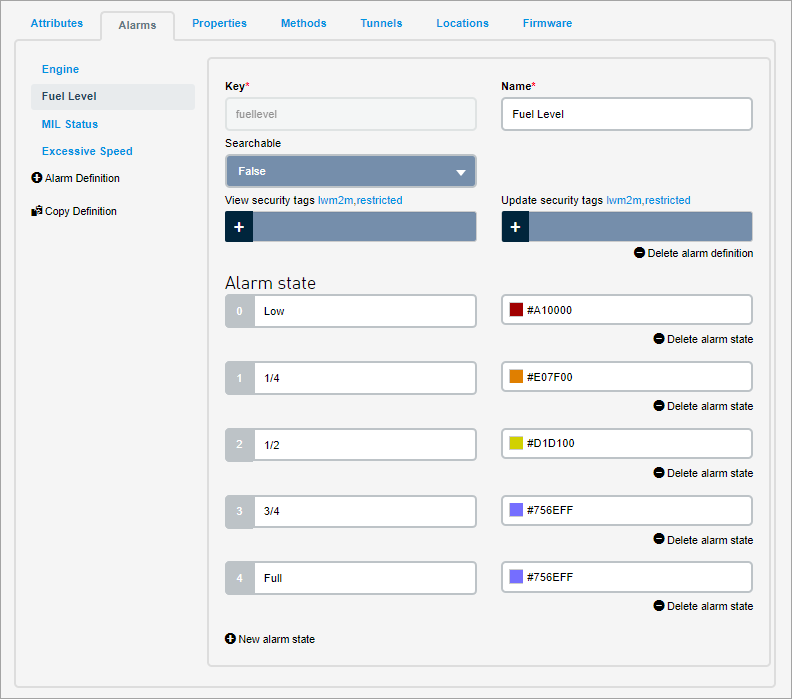Defining Alarms
The Alarms tab is used to define alarms for the Thing definition. Alarms are used to define events for a Thing. Alarms are implemented as a state machine, where the events are defined as alarm states.
For example:
- Defining an alarm for low level for a Thing that represents a gas tank of a vehicle
- Defining an alarm for whether the engine is ON or OFF that represents an engine of a vehicle
Things can have multiple alarms. It is possible to define up to 99 states for each alarms. Alarm states have a numeric alarm state value (assigned sequentially by the system), a text alarm state name, and a color (value) used when viewing the alarm on the Viewing a Thing in the Management Portal.
The numeric alarm state values are only visible in the Thing definition, but will not appear until after the Thing definition is saved.
Defining Alarms is a sub task while Creating a Thing definition or Editing a Thing definition. To define the Alarms, do the following:
-
While Creating a Thing
definition or Editing a Thing
definition, under the Standard tab, click on
the Alarms tab

- Enter or select the fields for the new alarm definition.
The fields are:
Field Description Key The key for the alarm definition.
A key is an identifier that must be globally unique within the organization.
The valid characters for a key are letters, numbers, "_" (underscore), and "-" (hyphen).To find all Things that have the attribute key set to a certain value through the 'Search' functionality, the precondition is that the attribute must be 'searchable'.
Only the data updated (with a new value's entry) after the attribute has been set searchable=true will be found; while the data updated before the attribute had searchable=true will remain not findable. In that case it is needed a workaround.Name The name of the alarm definition that is displayed on Management Portal pages. Searchable Indicates if this attribute is searchable. If set to true, you will be able to find the attribute while searching. For a Thing, the maximum number of attributes, alarms, or properties is limited to 32 each. If you have more than the permitted limit, then the attributes, alarms, or properties will not be indexed and is not searchable. View security tags Enter any number of tags to the alarm that control whether a user or application can view the alarm. The user or application must have a role that has the same view security tag associated with it in order to view an alarm with a view security tag associated with it. Update security tags Enter any number of tags to the attribute that control whether a user or application can update the alarm. The user or application must have a role that has the same update security tag associated with it in order to update an alarm with an update security tag associated with it. Alarm State Name: The name of the alarm state. Color: The color selection for the alarm state. This can be entered as a hex color code or selected from a color picker.
- Click on the
 to add a new alarm state
to add a new alarm state - Click on the
 to delete an existing state
to delete an existing state
- Click on the
- Click on the
 to add a New
alarm definition.
to add a New
alarm definition. - Click on the
 to delete the
currently displayed alarm definition.
to delete the
currently displayed alarm definition. - (optional)Click on the
 to list all the alarms from all the Thing definitions. You will be able to select the alarm you want and copy it to your Thing definition.
to list all the alarms from all the Thing definitions. You will be able to select the alarm you want and copy it to your Thing definition. - Click Add to add the Property
definition.
Alarms can be graphed, since they have a state and timestamp component.